Assessing Subsidence in Remote Reclaimed Islands by Integrating PPP, Leveling, and InSAR
Highlights
- The first integration of PPP, leveling, and InSAR into a unified framework achieves millimeter-scale accuracy for monitoring and assessing the safety of remote reclaimed islands.
- Integrated data reveal maximum displacements of 2 mm/yr at PPP points, 5 mm in leveling elevation, and InSAR deformation rates averaging −0.34 mm/yr with a peak of 18.60 mm/yr.
- The proposed framework successfully captured slow deformation and generated full-coverage settlement maps across point, linear, and areal scales, ultimately demonstrating the overall stability of the reclaimed island during the monitoring period.
- Our findings demonstrate the framework’s capability to delineate detailed defor-mation patterns and long-term trends, which is critical for predicting island stability and ensuring safety.
Abstract
1. Introduction
2. Materials and Methods
2.1. Study Area
2.2. Technical Workflow
2.3. PPP
2.3.1. Observation Model
2.3.2. Error Correction
2.4. Leveling
2.5. SBAS-InSAR
2.6. Data Acquisition and Processing
2.6.1. PPP Data
2.6.2. Leveling Data
2.6.3. InSAR Data
2.7. Stability Rating
3. Results
3.1. Observation Results of Benchmark Points Based on PPP
3.2. Leveling Measurement Monitoring Results
3.3. Deformation Monitoring Results Based on InSAR
4. Discussion
4.1. Accuracy Verification
4.2. Scalability Analysis of the Method
4.3. Strengths and Limitations of Monitoring Techniques
4.4. Analysis of Factors Affecting Marine Reclamation Island Uneven Subsidence
5. Conclusions
Author Contributions
Funding
Data Availability Statement
Conflicts of Interest
References
- Chen, W.; Wang, D.; Huang, Y.; Chen, L.; Zhang, L.; Wei, X.; Sang, M.; Wang, F.; Liu, J.; Hu, B. Monitoring and analysis of coastal reclamation from 1995–2015 in Tianjin Binhai New Area, China. Sci. Rep. 2017, 7, 3850. [Google Scholar] [CrossRef] [PubMed]
- Jiang, S.; Xu, N.; Li, Z.; Huang, C. Satellite derived coastal reclamation expansion in China since the 21st century. Glob. Ecol. Conserv. 2021, 30, e01797. [Google Scholar] [CrossRef]
- Radhi, H.; Sharples, S.; Assem, E. Impact of urban heat islands on the thermal comfort and cooling energy demand of artificial islands: A case study of AMWAJ Islands in Bahrain. Sustain. Cities Soc. 2015, 19, 310–318. [Google Scholar] [CrossRef]
- Nieuwenhout, C.; Andreasson, L.M. The legal framework for artificial energy islands in the northern seas. Int. J. Mar. Coast. Law 2023, 39, 39–72. [Google Scholar] [CrossRef]
- Wali, M.K. Practices and Problems of Land Reclamation in Western North America; University of North Dakota Press: Forks, ND, USA, 1975. [Google Scholar]
- Douglas, I.; Lawson, N. Airport construction: Materials use and geomorphic change. J. Air Trans. Manag. 2003, 9, 177–185. [Google Scholar] [CrossRef]
- Xu, C. Response of the Geomorphic Dynamics to the Artificial Island Construction in Complicated Bathymetry—A Case Study for the Radial Sand Ridges Field. Master’s Thesis, Nanjing University, Nanjing, China, 2015. [Google Scholar]
- Li, G.R.; Zhao, C.Y.; Wang, B.H.; Liu, X.J.; Chen, H.Y. Land subsidence monitoring and dynamic prediction of reclaimed islands with Multi-Temporal InSAR techniques in Xiamen and Zhangzhou cities, China. Remote Sens. 2022, 14, 2930. [Google Scholar] [CrossRef]
- Yang, M.; Yang, T.; Zhang, L.; Lin, J.; Qin, X.; Liao, M. Spatio-temporal characterization of a reclamation settlement in the Shanghai coastal area with time series analyses of X-, C-, and L-band SAR datasets. Remote Sens. 2018, 10, 329. [Google Scholar] [CrossRef]
- Yu, Z.F.; Li, B.; Qiu, W.; Xu, X.W. Research on settlement test and numerical calculation of west artificial island foundation of Hong Kong-Zhuhai-Macao Bridge. Ships Offshore Struct. 2021, 16 (Suppl. S2), 56–65. [Google Scholar] [CrossRef]
- Yin, Y.P.; Zhang, Z.C.; Zhang, K.J. Land subsidence and countermeasures for its prevention in China. Chin. J. Geol. Hazard Control. 2005, 16, 1–8. [Google Scholar]
- Pepe, A.; Bonano, M.; Zhao, Q.; Yang, T.; Wang, H. The use of C-/X-band time-gapped SAR data and geotechnical models for the study of Shanghai’s ocean-reclaimed lands through the SBAS-DInSAR technique. Remote Sens. 2016, 8, 911. [Google Scholar] [CrossRef]
- Fergason, K.C.; Rucker, M.L.; Panda, B.B. Methods for monitoring land subsidence and earth fissures in the Western USA. In Proceedings of the Ninth International Symposium on Land Subsidence, Nagoya, Japan, 15–19 November 2015; pp. 361–366. [Google Scholar]
- He, X.F.; Gao, Z.; Xiao, R.Y.; Luo, H.B.; Jia, D.Z.; Zhang, Z.T. Application and prospect of the integration of InSAR and BDS/GNSS for land surface deformation monitoring. Acta Geod. Et Cartogr. Sin. 2022, 51, 1338–1355. [Google Scholar]
- Li, Z.H.; Zhu, W.; Yu, S.; Zhang, Q.; Zhang, C.L.; Liu, Z.J.; Zhang, X.S.; Chen, B.; Du, J.T.; Song, C.; et al. Interferometric synthetic aperture radar for deformation mapping: Opportunities, Challenges and the outlook. Acta Geod. Et Cartogr. Sin. 2022, 51, 1485–1519. [Google Scholar]
- Ma, D.M.; Zhao, R.; Li, Y.S.; Li, Z.G. Land subsidence assessment of archipelago based on the InSAR time series analysis method. Water 2023, 15, 465. [Google Scholar] [CrossRef]
- Yang, C.X.; Hu, Z.G.; Dai, K.Z. Applications and development of fiber optic sensors. J. Wuhan Inst. Chem. Technol. 2004, 26, 63–66. [Google Scholar]
- Xi, J. Distributed Optical Fiber Monitoring Technology on Deformation of Land Subsidence. Master’s Thesis, Nanjing University, Nanjing, China, 2012. [Google Scholar]
- Ma, J.Y. Meticulously research on land subsidence in coastal area of Jiangsu at different scales. Master’s Thesis, Nanjing University, Nanjing, China, 2018. [Google Scholar]
- Zhang, Q.; Huang, G.W.; Yang, C.S. Precision space observation technique for geological hazard monitoring and early warning. Acta Geod. Et Cartogr. Sin. 2017, 46, 1300–1307. [Google Scholar]
- Berardino, P.; Fornaro, G.; Lanari, R.; Sansosti, E. A new algorithm for surface deformation monitoring based on small baseline di_erential SAR interferograms. IEEE Trans. Geosci. Remote Sens. 2002, 40, 2375–2383. [Google Scholar] [CrossRef]
- Nagler, T.; Rott, H.; Kamelger, A. Analysis of Landslides in Alpine Areas by Means of SAR Interferometry. In Proceedings of the IEEE International Geoscience and Remote Sensing Symposium, Toronto, ON, Canada, 24–28 June 2002. [Google Scholar]
- Ferretti, A.; Savio, G.; Barzaghi, R.; Borghi, A.; Musazzi, S.; Novali, F.; Prati, C.; Rocca, F. Submillimeter accuracy of InSAR time series: Experimental validation. IEEE Trans. Geosci. Remote Sens. 2007, 45, 1142–1153. [Google Scholar] [CrossRef]
- Wang, T.; Perissin, D.; Liao, M.; Rocca, F. Deformation Monitoring by Long Term D-InSAR Analysis in Three Gorges Area, China. In Proceedings of the IEEE International Geoscience and Remote Sensing Symposium, Boston, MA, USA, 8–11 July 2008. [Google Scholar]
- Perissin, D.; Wang, T. Time-Series InSAR Applications Over Urban Areas in China. IEEE J. Sel. Top. Appl. Earth Obs. Remote Sens. 2011, 4, 92–100. [Google Scholar] [CrossRef]
- Herrera, G.; Gutiérrez, F.; García-Davalillo, J.C.; Guerrero, J.; Notti, D.; Galve, J.P.; Fernández-Merodo, J.A.; Cooksley, G. Multi-sensor advanced DInSAR monitoring of very slow landslides: The Tena Valley case study(Central Spanish Pyrenees). Remote Sens. Environ. 2013, 128, 31–43. [Google Scholar] [CrossRef]
- Aslan, G.; Cakır, Z.; Ergintav, S.; Lasserre, C.; Renard, F. Analysis of secular ground motions in Istanbul from a long-term InSAR time-series (1992–2017). Remote Sens. 2018, 10, 408. [Google Scholar] [CrossRef]
- Zhao, Q.; Ma, G.; Wang, Q.; Yang, T.; Liu, M.; Gao, W.; Falabella, F.; Mastro, P.; Pepe, A. Generation of long-term InSAR ground displacement time-series through a novel multi-sensor data merging technique: The case study of the Shanghai coastal area. ISPRS J. Photogramm. Remote Sens. 2019, 154, 10–27. [Google Scholar] [CrossRef]
- Liu, X.; Zhao, C.; Zhang, Q.; Yang, C.; Zhang, J. Characterizing and monitoring ground settlement of marine reclamation land of Xiamen New Airport, China with Sentinel-1 SAR Datasets. Remote Sens. 2019, 11, 585. [Google Scholar] [CrossRef]
- Wu, S.; Yang, Z.; Ding, X.; Zhang, B.; Zhang, L.; Lu, Z. Two decades of settlement of Hong Kong International Airport measured with multi-temporal InSAR. Remote Sens. Environ. 2020, 248, 111976. [Google Scholar] [CrossRef]
- Shi, X.; Chen, C.; Dai, K.; Deng, J.; Wen, N.; Yin, Y.; Dong, X. Monitoring and Predicting the Subsidence of Dalian Jinzhou Bay International Airport, China by Integrating InSAR Observation and Terzaghi Consolidation Theory. Remote Sens. 2022, 14, 2332. [Google Scholar] [CrossRef]
- Liu, F.Q. Study on Community Diversity and Physical and Chemical Property of Soil of Interlace Zone of Sandy Coastal in Shandong. Master’s Thesis, Shandong Agricultural University, Taian, China, 2009. [Google Scholar]
- Zhang, Z.H. Study on Impacts of the Haiyang Harbor’s Construction on the Sandy Coast. Master’s Thesis, Ocean University of China, Qingdao, China, 2012. [Google Scholar]
- Yue, N.N. Impact Studies of the Man-Made Island Project to the Vicinity Area on the Sandy Coast. Master’s Thesis, Ocean University of China, Qingdao, China, 2008. [Google Scholar]
- Wang, Y.Z.; Tian, Z.W.; Li, X.; Sun, H.F. Coastal erosion mechanism and its prevention in Haiyang. Mar. Sci. 2021, 45, 18–30. [Google Scholar]
- Xie, H.; Yang, Y.H.; Zhu, L.H.; Zhang, X.D.; Hu, R.J.; Yin, Y.J.; Leng, X. Seasonal evolution of the typical sandy coast of southeastern Shangdong Peninsula and controlling factors-Take the 10000-meter beach in Haiyang as an example. Mar. Geol. Quat. Geol. 2022, 42, 57–67. [Google Scholar]
- Zumberge, J.F.; Heflin, M.B.; Jefferson, D.C.; Watkins, M.M.; Webb, F.H. Precise point positioning for the efficient and robust analysis of GPS data from large networks. J. Geophys. Res. 1997, 102, 5005–5017. [Google Scholar] [CrossRef]
- Kouba, J.; Heroux, P. Precise point positioning using IGS orbit and clock products. GPS Solut. 2001, 5, 12–28. [Google Scholar] [CrossRef]
- Ge, M.; Gendt, G.; Rothacher, M.; Shi, C.; Liu, J. Resolution of GPS carrier-phase ambiguities in precise point positioning (PPP) with daily observations. J. Geod. 2008, 82, 389–399. [Google Scholar] [CrossRef]
- Teunissen, P.J.G.; Huisman, L.; Hu, C. Real-time precise point positioning in NAD83: Global and regional broadcast corrections compared. J. Surv. Eng. 2012, 139, 1–10. [Google Scholar] [CrossRef]
- Zhang, X.; Li, P. Assessment of correct fixing rate for precise point positioning ambiguity resolution on a global scale. J. Geod. 2013, 87, 579–589. [Google Scholar] [CrossRef]
- Yi, Z.H. Research on Real-Time Precise Point Positioning Theory and Application. Ph.D. Thesis, Central South University, Changsha, China, 2011. [Google Scholar]
- Li, X.X. Rapid Ambiguity Resolution in GNSS Precise Point Positioning. Ph.D. Thesis, Wuhan University, Wuhan, China, 2013. [Google Scholar]
- Yao, Y.B.; Hu, Y.F.; Yu, C. An improved global zenith tropospheric delay model. Acta Geod. Et Cartogr. Sin. 2015, 44, 242–249. [Google Scholar]
- Huang, G.W.; Zhang, R.; Zhang, Q.; Guo, H.R.; Wang, L. Comparison and Analysis of Different Models of Antenna Phase Center Correction of BDS Satellites. J. Geod. Geodyn. 2015, 35, 658–661. [Google Scholar]
- Sun, H.P.; Xu, H.Z.; Chen, W.; Chen, X.D.; Zhou, J.C.; Liu, M.; Gao, S. Study of Earth’s gravity tide and oceanic loading characteristics in Hong Kong area. Chin. J. Geophys. 2006, 49, 724–734. [Google Scholar] [CrossRef]
- Zhao, H.; Zhang, Q.; Xu, C.; Qu, W.; Liu, Z. Analysis of ocean tide loading effect on GPS PPP of Hong Kong. J. Geod. Geodyn. 2016, 36, 6–10. [Google Scholar]
- Zhang, X.H.; Ma, L.; Li, P. Determination of ocean tide loading displacements using kinematic PPP. Acta Geod. Et Cartogr. Sin. 2016, 45, 631–638. [Google Scholar]
- GB/T 12897—2006; Specifications for the First and Second Order Leveling. Standards Press of China: Beijing, China, 2006.
- Zebker, H.A.; Werner, C.L.; Rosen, P.A.; Hensley, S. Accuracy of topographic maps derived from ERS-1 interferometric radar. IEEE Trans. Geosci. Remote Sens. 1994, 32, 823–836. [Google Scholar] [CrossRef]
- Hanssen, R.F. Radar Interferometry: Data Interpretation and Error Analysis; Springer: Dordrech, The Netherlands; Kluwer Academic Publishers: Dordrech, The Netherlands, 2001. [Google Scholar]
- Lanari, R.; Mora, O.; Manunta, M.; Mallorqui, J.J.; Berardino, P.; Sansosti, E. A small-baseline approach for investigating deformations on full-resolution differential SAR interferograms. IEEE Trans. Geosci. Remote Sens. 2004, 42, 1377–1386. [Google Scholar] [CrossRef]
- Casu, F.; Manzo, M.; Lanari, R. A quantitative assessment of the SBAS algorithm performance for surface deformation retrieval from DInSAR data. Remote Sens. Environ. 2006, 102, 195–210. [Google Scholar] [CrossRef]
- Wang, Z.K.; Liu, X.L.; Zhang, S.P.; Meng, X.S.; Zhang, H.J.; Guo, X.S. Multi-scenario land use and carbon storage assessment in the Yellow River Delta under climate change and resource development. Remote Sens. 2025, 17, 1603. [Google Scholar] [CrossRef]
- Li, S.; Xu, W.; Li, Z. Review of the SBAS InSAR Time-series algorithms, applications, and challenges. Geod. Geodyn. 2022, 13, 114–126. [Google Scholar] [CrossRef]
- Farr, T.G.; Rosen, P.A.; Caro, E.; Crippen, R.; Duren, R.; Hensley, S.; Kobrick, M.; Paller, M.; Rodriguez, E.; Roth, L.; et al. The shuttle radar topography mission. Rev. Geophys. 2007, 45, 114–126. [Google Scholar] [CrossRef]
- Yu, Y.H.; Balz, T.; Luo, H.; Liao, M.S.; Zhang, L. GPU accelerated interferometric SAR processing for Sentinel-1 TOPS data. Comput. Geosci. 2019, 129, 12–25. [Google Scholar] [CrossRef]
- Duan, H.Z.; Li, Y.S.; Li, B.Q.; Li, H. Fast InSAR time-series analysis method in a full-resolution SAR coordinate system: A case study of the Yellow River Delta. Sustainability 2022, 14, 10597. [Google Scholar] [CrossRef]
- Schmidt, D.A.; Bürgmann, R. Time-dependent land uplift and subsidence in the Santa Clara Valley, California, from a large interferometric synthetic aperture radar data set. J. Geophys. Res. Solid Earth 2003, 108, 2416. [Google Scholar] [CrossRef]
- Hooper, A. A multi-temporal InSAR method incorporating both persistent scatterer and small baseline approaches. Geophys. Res. Lett. 2008, 35, L16302. [Google Scholar] [CrossRef]
- HY/T 0487-2025; Technical Specification for Stability Monitoring of Islands Where the Territorial Sea Base Point is Located. Standards Press of China: Beijing, China, 2025.
- Bürgmann, R.; Rosen, P.A.; Fielding, E.J. Synthetic aperture radar interferometry to measure earth’s surface topography and its deformation. Annu. Rev. Earth Planet. Sci. 2000, 28, 169–209. [Google Scholar] [CrossRef]
- Del Soldato, M.; Confuorto, P.; Bianchini, S.; Sbarra, P.; Casagli, N. Review of Works Combining GNSS and InSAR in Europe. Remote Sens. 2021, 13, 1684. [Google Scholar] [CrossRef]
- Parizzi, A.; Brcic, R.; Zan, F.D. InSAR Performance for Large-Scale Deformation Measurement. IEEE Trans. Geosci. Remote Sens. 2021, 59, 8510–8520. [Google Scholar] [CrossRef]
- Michael, H.; Mohamed, A.; Esayas, G.; Dorina, M.; Michael, S. Land subsidence in the Texas coastal bend: Locations, rates, triggers, and consequences. Remote Sens. 2022, 14, 192. [Google Scholar]
- Hussain, M.A.; Chen, Z.; Shoaib, M.; Shah, S.U.; Khan, J.; Ying, Z. Land subsidence of coastal city of Pakistan using persistent scatterers In-SAR technique. Sci. Rep. 2022, 12, 5294. [Google Scholar] [CrossRef] [PubMed]
- Remy, M.A.; De Macedo, K.A.C.; Moreira, J.R. The first UAV-based P- and X-band interferometric SAR system. In Proceedings of the 2012 IEEE International Geoscience and Remote Sensing Symposium, Munich, Germany, 22–27 July 2012. [Google Scholar]
- Zhang, L.; Qiao, Z.J.; Xing, D.M.; Yang, L.; Bao, Z. A robust motion compensation approach for UAV SAR imagery. IEEE Trans. Geosci. Remote Sens. 2012, 50, 3202–3218. [Google Scholar] [CrossRef]
- Wang, Y.F.; Liu, C.; Zhan, X.L.; Han, S. Technology and applications of UAV synthetic aperture radar system. J. Radars 2016, 5, 333–349. [Google Scholar]
- Palm, S.; Sommer, R.; Janssen, D.; Tessmann, A.; Stilla, U. Airborne Circular W-Band SAR for Multiple Aspect Urban Site Monitoring. IEEE Trans. Geosci. Remote Sens. 2019, 57, 6996–7016. [Google Scholar] [CrossRef]
- Li, Q.J. An overview of Unmanned Airborne Miniature’s Development. Digit. Technol. Appl. 2019, 37, 197–202. [Google Scholar]
- Chu, L.N.; Guo, L.; Ma, Y.H.; Shi, Y.P.; Liang, W.B. Review of circular SAR imaging by a small rotor unmanned aerial vehicle. J. Ordnance Equip. Eng. 2025, 46, 303–316. [Google Scholar]
- Chang, M.; Yin, H.Q.; Su, G.L.; Tian, X.; Xu, Y.J. Spatial-temporal characteristics of land subsidence in Tianjin city based on leveling data. Bull. Surv. Mapp. 2020, 88–92. [Google Scholar]
- Ge, D.Q.; Wang, Y.; Fan, J.H.; Liu, S.W.; Guo, X.F.; Wang, Y. A study of surface deformation monitoring using differential SAR interferometry technique and analysis of its key problems. Remote Sens. Nat. Resour. 2007, 4, 14–22. [Google Scholar]
- Zhao, J.M.; Chen, H.; Gan, W.J.; Wang, Z.H. Error analysis of the monitoring precision of the land surface small deformation on heavy rail with interferometry synthetic aperture radar. J. Transp. Eng. Inf. 2009, 7, 22–32. [Google Scholar]
- Li, X.X.; Huang, J.X.; Li, X.; Shen, Z.H.; Han, J.J.; Li, L.Y.; Wang, B. Review of PPP-RTK: Achievements, challenges, and opportunities. Satell. Navig. 2022, 3, 28. [Google Scholar] [CrossRef]
- Elsheikh, M.; Iqbal, U.; Noureldin, A.; Korenberg, M. The implementation of precise point positioning (PPP): A comprehensive review. Sensors 2023, 23, 8874. [Google Scholar] [CrossRef]
- Liu, P.L.; Shen, X.D.; Liu, J.J.; Qiao, T.R. Application of GPS technology in land subsidence monitoring. Geospat. Inf. 2020, 18, 52–54. [Google Scholar]
- Zhang, Y.H.; Li, M.J.; Wu, H.A.; Liu, B.; Kang, Y.H.; He, Q. Ground subsidence monitoring over full territory of Jiangsu province with InSAR. Sci. Surv. Mapp. 2019, 44, 114–120. [Google Scholar]
- Li, D.R. InSAR: Technological progress and its application to land subsidence monitoring. Shanghai Land Resour. 2013, 34, 1–6. [Google Scholar]
- Ferretti, A.; Prati, C.; Rocca, F. Permanent scatterers in SAR interferometry. IEEE Trans. Geosci. Remote Sens. 2001, 39, 8–20. [Google Scholar] [CrossRef]
- Zhu, J.J.; Li, Z.W.; Hu, J. Research progress and methods of InSAR for deformation monitoring. Acta Geod. Et Cartogr. Sin. 2017, 46, 1717–1733. [Google Scholar]
- Liu, Y.H.; Wang, G.Q.; Yu, X.; Wang, K. Sentinel-1 InSAR and GPS-integrated long-term and seasonal subsidence monitoring in Houston, Texas, USA. Remote Sens. 2022, 14, 6184. [Google Scholar] [CrossRef]
- Dan, G.; Sultan, N.; Savoye, B. The 1979 Nice harbour catastrophe revisited: Trigger mechanism inferred from geotechnical measurements and numerical modelling. Mar. Geol. 2007, 245, 40–64. [Google Scholar] [CrossRef]
- Fujima, K.; Shigihara, Y.; Tomita, T.; Honda, K.; Nobuoka, H.; Hanzawa, M.; Ohtani, H.; Orishimo, S.; Tatsumi, M. Survey results of the Indian Ocean tsunami in the Maldives. Coast. Eng. J. 2006, 48, 81–97. [Google Scholar] [CrossRef]
- Puzrin, A.M.; Alonso, E.E.; Pinyol, N.M. Unexpected excessive settlements: Kansai International Airport, Japan. In Geomechanics of Failures; Springer: Dordrecht, The Netherlands, 2010; pp. 23–43. [Google Scholar]
- Mesri, G.; Funk, J.R. Settlement of the Kansai International Airport Island. J. Geotech. Geoenviron. Eng. 2015, 141, 04014102. [Google Scholar] [CrossRef]
- Fan, P.X.; Wang, J.B.; Wang, D.R. The medium and long term settlement of reclamation airports. Prot. Eng. 2018, 40, 70–78. [Google Scholar]
- Zhao, Y. Study on Properties of Gravel Soil and Airport Settlement in Jinzhou Bay Reclamation area. Master’s Thesis, Jilin University, Changchun, China, 2021. [Google Scholar]
- Oumeraci, H. Review and analysis of vertical breakwater failures-lessons leaned. Coast. Eng. 1994, 22, 3–29. [Google Scholar] [CrossRef]
- Jiang, X.L. Risk Analysis and Management of Breakwaters. Ph.D. Thesis, Tianjin University, Tianjin, China, 2006. [Google Scholar]
- Li, Y.B.; Jiang, X.L.; Liu, R. Discussion on the relationship between characteristics and the reasons of breakwater failures. Ocean. Eng. 2006, 24, 130–138. [Google Scholar]
- Jiao, Z.B.; Li, Y.H.; Lou, Y.; He, N. Automatic safety monitoring system and warning modes for artificial islands in coastal areas. Chin. J. Geotech. Eng. 2012, 34, 1712–1715. [Google Scholar]
- Cavalié, O.; Sladen, A.; Kelner, M. Detailed quantification of delta subsidence, compaction and interaction with man-made structures: The case of the NCA airport, France. Nat. Hazards Earth Syst. Sci. Discuss. 2015, 3, 3761–3788. [Google Scholar] [CrossRef]
- Watabe, Y. Discussion of ‘Settlement of the Kansai International Airport Islands’ by G. Mesri J. R. Funk. J. Geotech. Geoenvironmental Eng. 2016, 142, 07016007. [Google Scholar] [CrossRef]
- Zhao, W. Settlement Prediction of Artificial Island Revetment Considering Creep. Master’s Thesis, Dalian University of Technology, Dalian, China, 2020. [Google Scholar]
- Yang, X.F.; Han, X.H.; Di, Y.P.; Guo, X.T. Practice of subsidence monitoring of artificial island based on levelling technology. Hydrogr. Surv. Charting 2021, 41, 57–60. [Google Scholar]
- Plant, G.W.; Covil, C.S. Site Preparation for the New Hong Kong International Airport-The Design, Construction and Performance of the Airport Platform; Thomas Telford Publishing: London, UK, 1998. [Google Scholar]
- Jiang, L.M.; Lin, H. Integrated analysis of SAR interferometric and geological data for investigating long-term reclamation settlement of Chek Lap Kok Airport, Hong Kong. Eng. Geol. 2010, 110, 77–92. [Google Scholar] [CrossRef]
- Guo, H.; Jiao, J. Changes of coastal groundwater systems in response to large-scale land reclamation. In New Topics in Water Resources Research and Management; Andreassen, H.M., Ed.; Nova Science Publishers: New York, NY, USA, 2007; pp. 79–136. [Google Scholar]
- Teatini, P.; Strozzi, T.; Tosi, L.; Wegmüller, U.; Werner, C.; Carbognin, L. Assessing short- and long-time displacements in the Venice coastland by synthetic aperture radar interferometric point target analysis. J. Geophys. Res. 2007, 112, F01012. [Google Scholar] [CrossRef]
- Ma, C. Research on Artificial Island Landscape Design Based on Haiyang Lianli Island. Master’s Thesis, Qingdao Agricultural University, Qingdao, China, 2017. [Google Scholar]
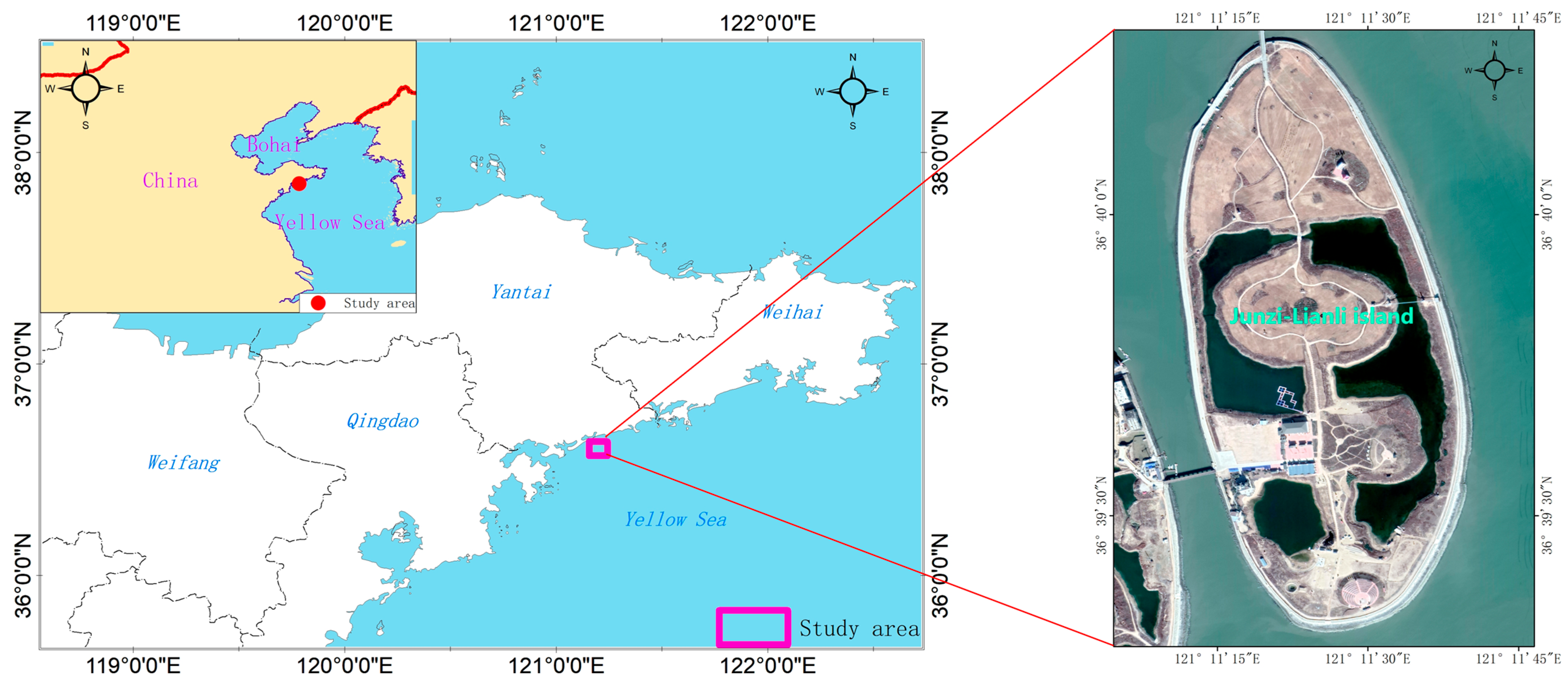
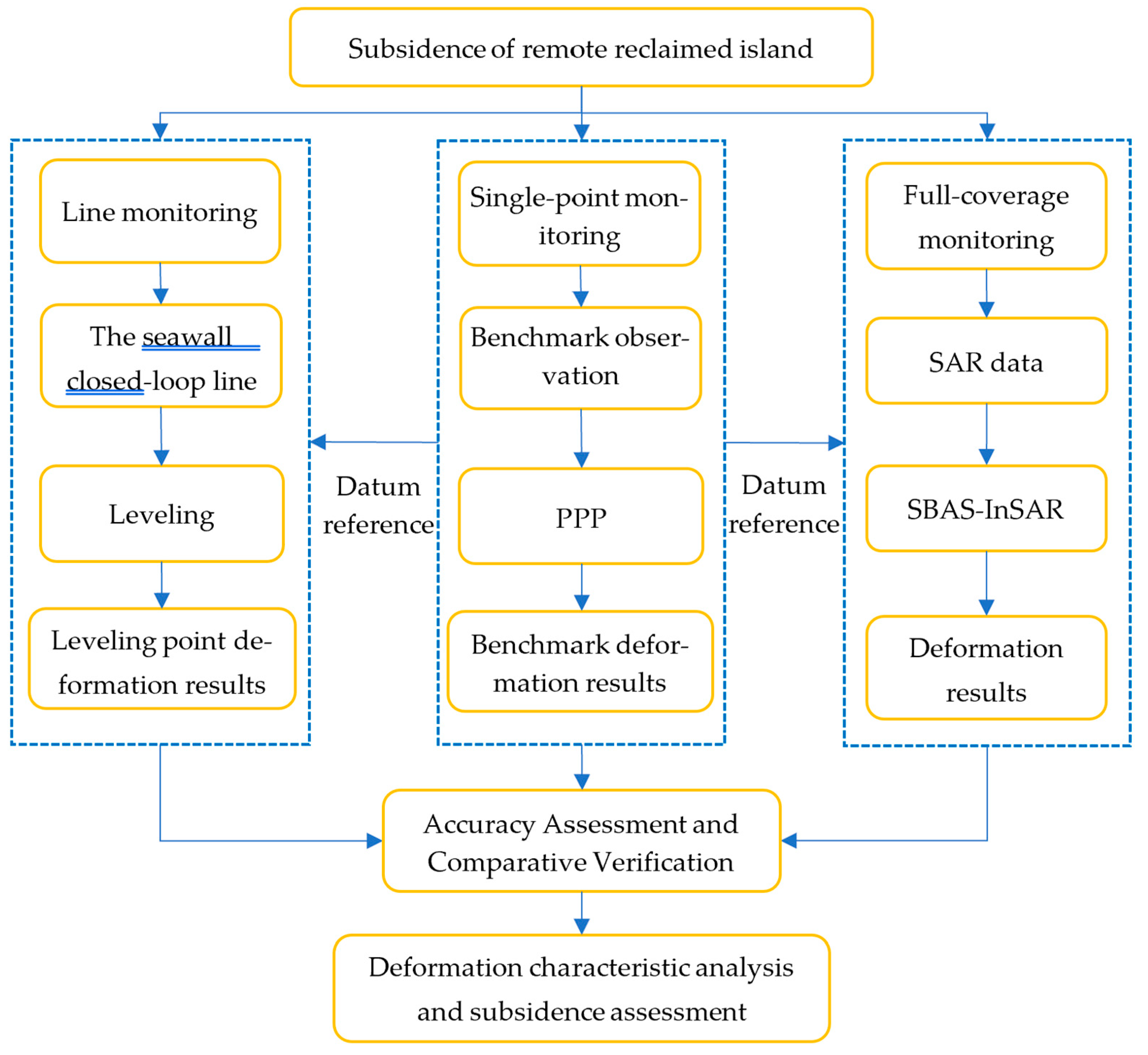



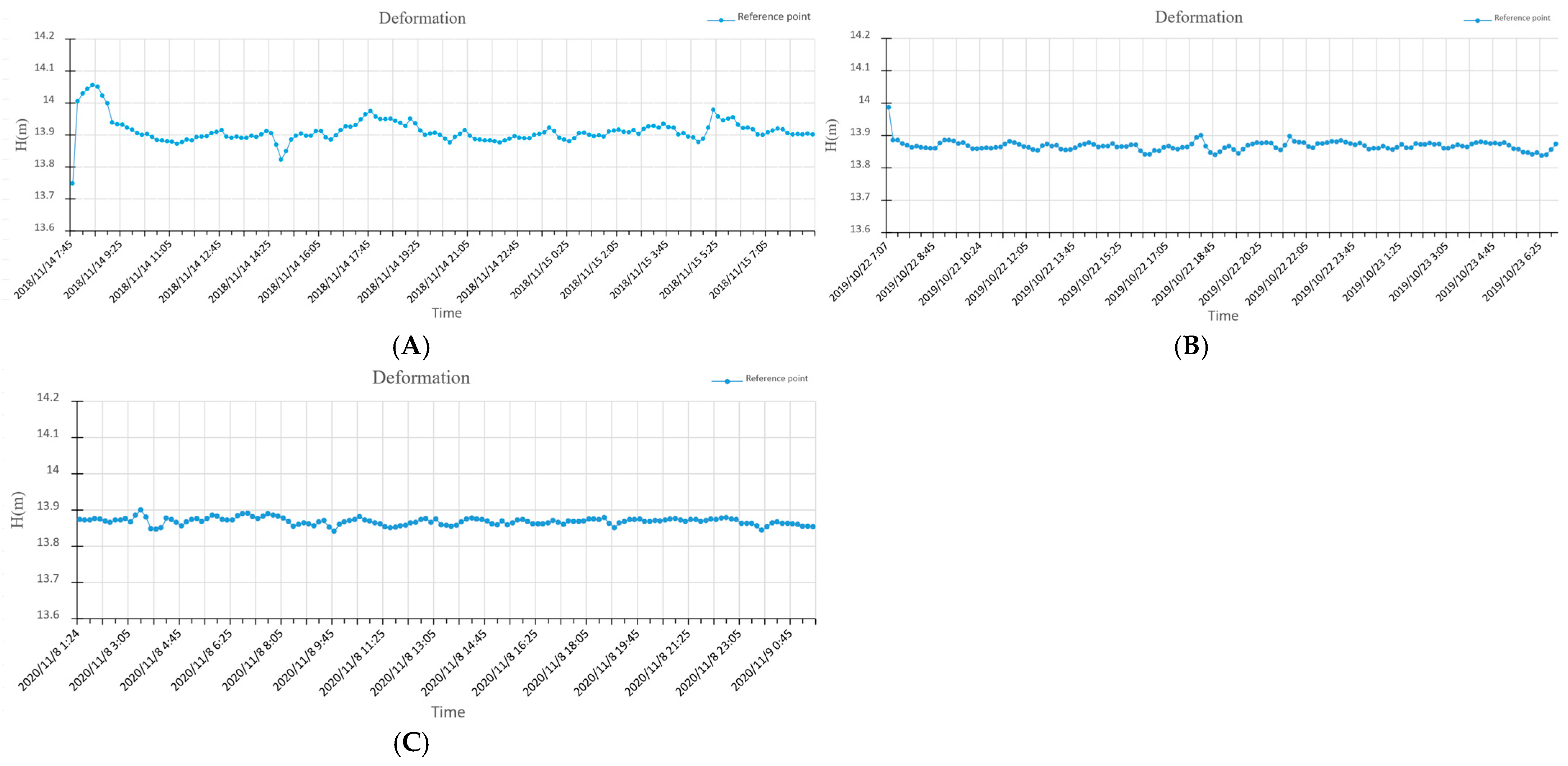

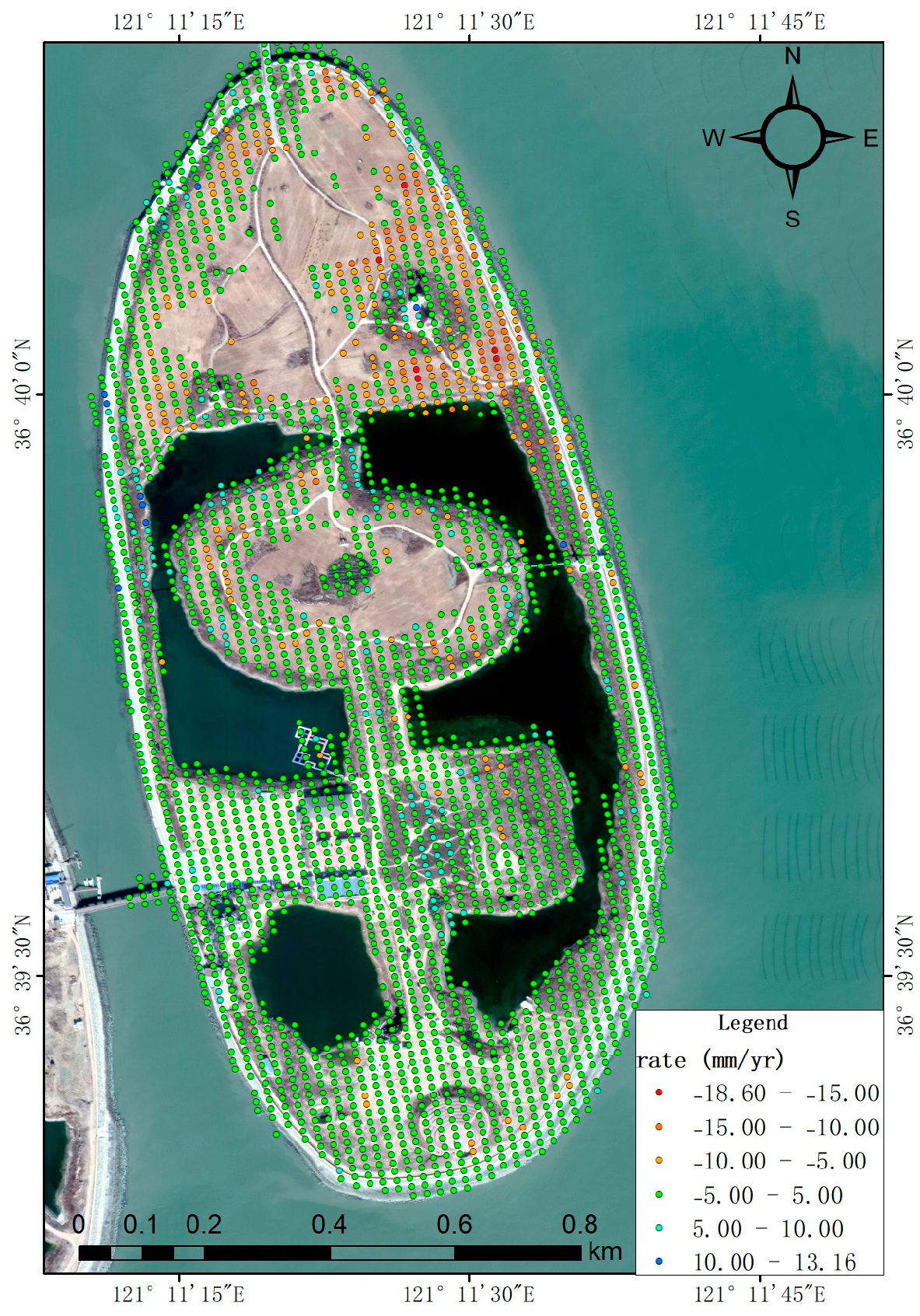
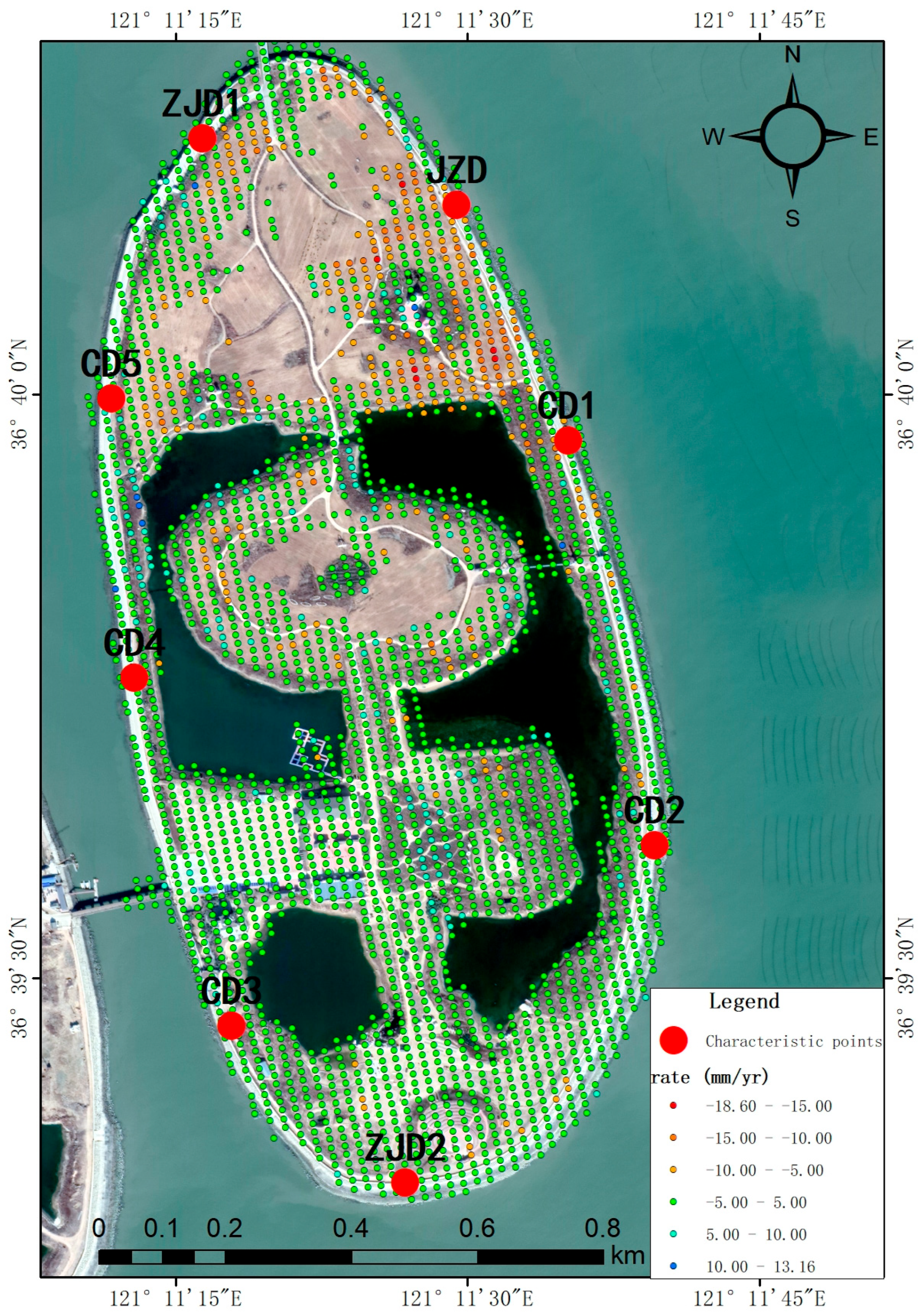
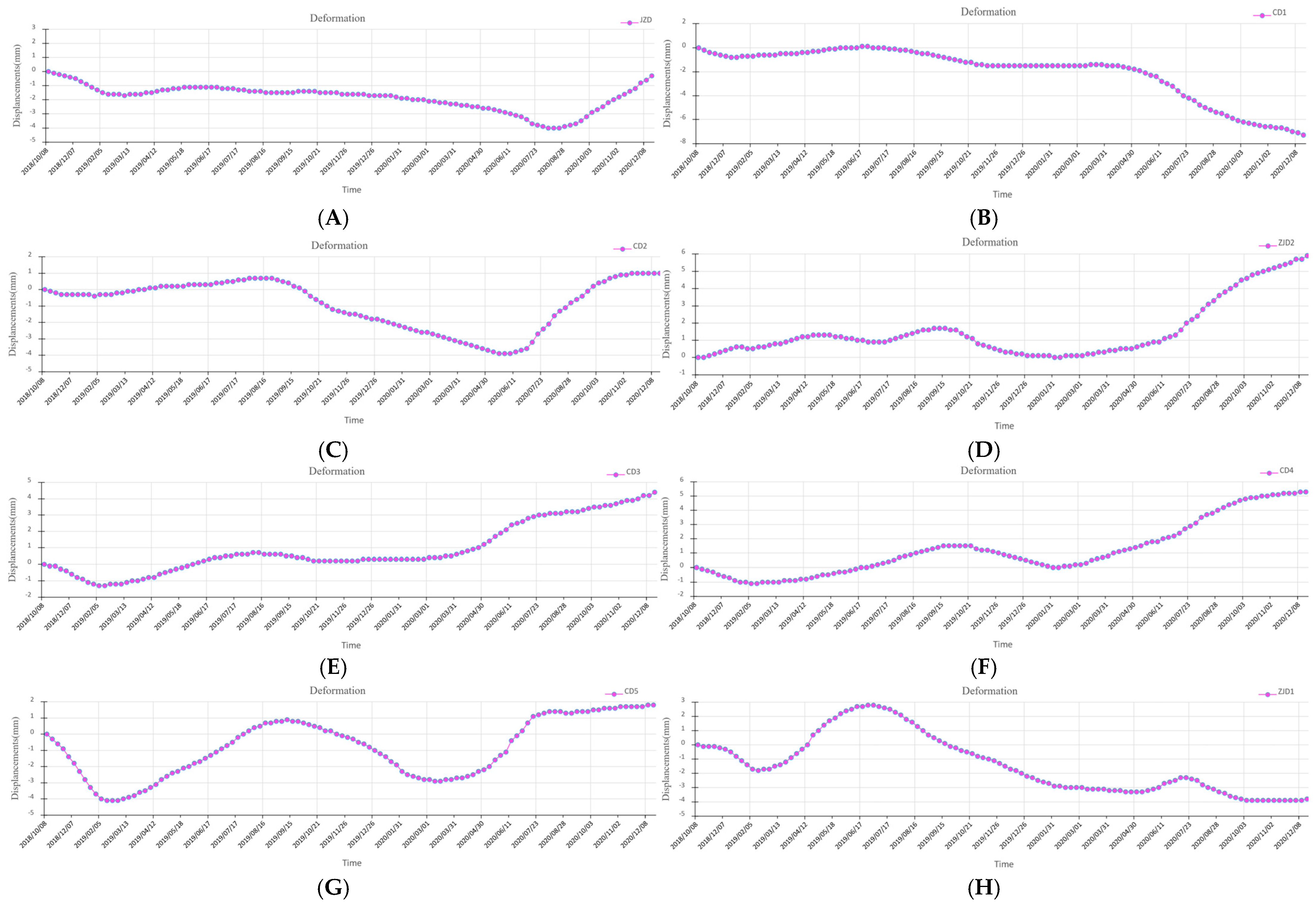
| Stability Status | Average Rate of Settlement or Uplift (mm/a) | Cumulative Settlement or Uplift (mm) |
|---|---|---|
| Unstable | ≥30 | ≥400 |
| Basically Stable | 10~30 | 150~400 |
| Stable | ≤10 | ≤150 |
| Point Id | November 2018 Monitored Elevation (m) | October 2019 Monitored Elevation (m) | November 2020 Monitored Elevation (m) | Elevation Difference Between Phase I and II (m) | Elevation Difference Between Phase II and III (m) |
|---|---|---|---|---|---|
| JZD | 13.866 | 13.868 | 13.868 | 0.002 | 0 |
| ZJD1 | 12.404 | 12.409 | 12.411 | 0.005 | 0.002 |
| CD5 | 12.102 | 12.104 | 12.104 | 0.002 | 0 |
| CD4 | 12.503 | 12.505 | 12.505 | 0.002 | 0 |
| CD3 | 13.779 | 13.783 | 13.781 | 0.004 | −0.002 |
| ZJD2 | 13.8 | 13.803 | 13.801 | 0.003 | −0.002 |
| CD2 | 13.723 | 13.726 | 13.725 | 0.003 | −0.001 |
| CD1 | 13.772 | 13.775 | 13.775 | 0.003 | 0 |
| Point Id | Elevation Changes from Leveling Surveys (2018–2020)/mm | InSAR-Derived Elevation Changes (2018–2020)/mm | Elevation Difference Between Two Monitoring methods (mm) |
|---|---|---|---|
| JZD | 2 | −1.81 | −3.81 |
| ZJD1 | −3 | −1.68 | 1.32 |
| CD5 | 2 | −1.83 | −3.83 |
| CD4 | 2 | 1.43 | −0.57 |
| CD3 | 2 | 1.04 | −0.96 |
| ZJD2 | 1 | 1.77 | 0.77 |
| CD2 | 2 | −1.25 | −3.25 |
| CD1 | 3 | −2.41 | −5.41 |
Disclaimer/Publisher’s Note: The statements, opinions and data contained in all publications are solely those of the individual author(s) and contributor(s) and not of MDPI and/or the editor(s). MDPI and/or the editor(s) disclaim responsibility for any injury to people or property resulting from any ideas, methods, instructions or products referred to in the content. |
© 2025 by the authors. Licensee MDPI, Basel, Switzerland. This article is an open access article distributed under the terms and conditions of the Creative Commons Attribution (CC BY) license (https://creativecommons.org/licenses/by/4.0/).
Share and Cite
Ma, D.; Jia, Y.; Cheng, B.; Wang, Y.; Li, M. Assessing Subsidence in Remote Reclaimed Islands by Integrating PPP, Leveling, and InSAR. Remote Sens. 2025, 17, 3628. https://doi.org/10.3390/rs17213628
Ma D, Jia Y, Cheng B, Wang Y, Li M. Assessing Subsidence in Remote Reclaimed Islands by Integrating PPP, Leveling, and InSAR. Remote Sensing. 2025; 17(21):3628. https://doi.org/10.3390/rs17213628
Chicago/Turabian StyleMa, Deming, Yonggang Jia, Baoquan Cheng, Yabin Wang, and Menghao Li. 2025. "Assessing Subsidence in Remote Reclaimed Islands by Integrating PPP, Leveling, and InSAR" Remote Sensing 17, no. 21: 3628. https://doi.org/10.3390/rs17213628
APA StyleMa, D., Jia, Y., Cheng, B., Wang, Y., & Li, M. (2025). Assessing Subsidence in Remote Reclaimed Islands by Integrating PPP, Leveling, and InSAR. Remote Sensing, 17(21), 3628. https://doi.org/10.3390/rs17213628






